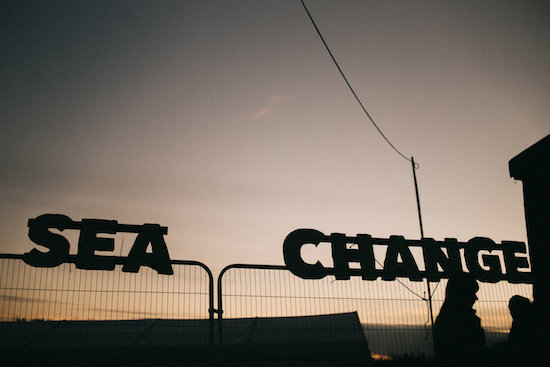Amid the verdancy of South Devon, where the River Dart heads down toward Shag Rock and the sea, down through the woods at Gallants Bower and out to a spectacular coastline, Totnes is a magnificent place to hold a music festival. It’s a town where rock and pop confluences add to a rich socio-cultural floodplain. This May, Totnes’s Sea Change Festival will see its fourth incarnation, staged in a sleepy settlement where The KLF, Blondie and The Fall have all previously walked the streets.
Jimmy Cauty of The KLF spent much of his youth in Totnes. The teenage Cauty’s artistic expression was in keeping with the town’s more tie-dyed traditions, and his intricate drawing of Gandalf from Lord Of The Rings became a best-selling poster for Athena. Another Cauty illustration featured on the cover of the album The King Of Elfland’s Daughter, made by members of Steeleye Span. On a more post-punk tangent, Blondie, The Fall and The Cure all – almost unbelievably – played in Totnes Civic Hall around the dawn of the 1980s, beside the town’s market square. Today in Totnes the Gandalf / Elfland vibe is maintained by Totnes’s discreet selection of crystal-and-joss-stick outlets. This mystic mindset can be traced to the 1960s and 1970s, when kaftan-clad students attended Dartington College of Arts, just out of town. More recently road-sign graffiti rogues have twinned Totnes with both Narnia and Area 51. Less mystically, Totnes is also a centre of practical environmental action, home to the Transition movement.
Sea Change Festival has built memorably on Totnes’ cultural traditions. In the festival’s three examples to date, artists including Damo Suzuki, Andrew Weatherall, British Sea Power, Cosey Fanni Tutti and Bo Ningen have reconfigured the Devon calm. On a more Arcadian angle, Shirley Collins, Ryley Walker, James Yorkston and Alasdair Roberts have all played. Charles Babbage, the 19th-century "father of the computer", went to school in Totnes, formulating ideas that would later be realised in his Analytical Engine. This machine’s integrated memory was a way-mark on the route to the digital landscape of today’s pop music. But Babbage’s Engine met its match when Throbbing Gristle’s Chris Carter brought his bespoke "Gristleizer" circuitry to last year’s Sea Change, pulsing out glorious waves of bleeps and basslines. At the 2017 Sea Change it felt like a freakish privilege to experience the wondrous Aldous Harding in a lovely 150-capacity room – stood on the Barrel House’s old sprung dancefloor, by the big windows and looking out on a high street that last saw such levels of excitement when a cart of carrots overturned in 1871.
This year Sea Change pivots between town venues and various parts of beautiful Dartington Hall, a mile away. The 14th-century Great Hall is a glorious interior, with heraldry and hammerbeams to satiate the most blood-drenched dreams of the Game Of Thrones / Hogwarts massif. At Sea Change the Great Hall will feature a performance from theUkrainian piano virtuoso Lubomyr Melnyk. The adjacent High Cross House, meanwhile, is a modernist masterpiece, built in 1932 to a design by the Swiss-American architect William Lescaze. At Sea Change, High Cross House will be home to talks and a performance from punk-funk insurrectionists The Pop Group.
There is also peculiarity and intrigue in the history of Dartington Hall. The Hall was founded some time in the 12th century. In 1925 it was bought as wreck by the idealistic and moneyed Dorothy and Leonard Elmhirst, who subsequently made the place home to progressive social and artistic ideas. These included Dartington School Hall, founded in 1926 and run on liberal lines. Over the years pupils included both Clement and Lucian Freud and, indeed, Oliver Postage. Not to mention to two titular components of Marshall Hain, authors of 1978 UK chart smash ‘Dancing In The City’. At the school pupils were given a substantial say in the school’s mood and programme. Staying in bed could be presented as an eductational alternative. The school was eventually closed in 1987, after some troubled times in its latter years. A female student drowned in the river in mysterious circumstances. The headmaster and his wife were found to have once posed for a porn-mag photo shoot. Earlier the school had become the model for a school in The Haunting of Toby Jugg, a 1947 novel by the occult-thriller writer Dennis Wheatley. In the book the school is a hotbed of occult activity – the doormats woven with images of the cross, thus encouraging the school population to wipe their feet on the idea of Christianity. In the real world Dartington Hall was seen by parts of the UK establishment as a potential hotbed of subversion and communism. Years later it was found that MI5 had run a file on Dartington Hall.
The main Sea Change stages will be five minutes’ walk from High Cross House, on lush pasture land. Over the brow of the hill lives Dartington’s herd of fallow deer. Here, the likes of Metronomy, The Comet Is Coming and Black Midi will play. This main site will also feature Stewart Lee and the epochal folk-revenant music from TV’s Bagpuss, here presented by a cast that includes Daniel Postgate, son of Oliver Postgate, the man behind Bagpuss and The Clangers. Back in Totnes itself, Hannah Peel and Virginia Astley will perform within the vaulted interior of the 15th-century Church Of St Mary. There will be talks in the Barrel House, from parties including Rough Trade Books, the charismatic literary maniac David Keenan and The Quietus’s own Luke Turner. There will also be events in town at the delightful Totnes Cinema, including an audio-visual meditation on BBC Radiophonic Workshop composer Delia Derbyshire.
Sea Change is hosted by the town’s Drift Records – a sonic supermart suggestive of shops like Rough Trade East, but sat in a market town with a population of 8,000. As The Guardian noted, "The local record shop, Drift, is mind-bogglingly great, the kind of place that you’d think was amazing if you found it in New York." This year at Sea Change there is particular connection with Totnes, care of Friday-night headliners Metronomy. The group’s mainman Joe Mount grew up in Totnes, and Metronomy’s debut album was named after some enduring Totnes oddity. The LP was called Pip Paine (Pay the £5000 You Owe). For as long as most people can recall, rusting automobiles have been left around Totnes, crudely daubed: "COUNCILLOR PIP PAINE PAY THE £5,000 YOU OWE". These wrecks allude to an ancient disputed business deal. This year Sea Change customised this scrapyard-screed tradition, creating their own marketing masterpiece. A knackered van was parked on a main road: "SEA CHANGE IV… BUY THE TICKETS YOU OWE US".

Getting around
With its Norman castle and steep tile-lined streets, Totnes has an age-old feel. There are, apparently, even older remnants. Totnes is the place where Brutus of Troy, mythical founder of Britain, is said to have first set foot on these islands. But adherents of the rock form will understand that this olden-days Brutus joker was just a portent of things to come – from the great 1990s glam-synth cerebral-brutalists of Earl Brutus. Legend says that Brutus of Troy and his followers had a big fight with the giant Gogmagog, in the vicinity of what is now Plymouth. This was, of course, merely a precursor to the latter-day booze-barneys on Plymouth’s Union Street – as celebrated in the 1996 Earl Brutus single ‘Navy Head’. Who can predict history’s flux and connection?
The best local insight your correspondent can maybe provide for this year’s Sea Change is to take time to walk the scenic route when gravitating between the town and Dartington. With a little forward planning you can head northeast past the mainline rail station, along footpaths by the River Dart and then, still following the river, along the tarmac’d Dartington Drive. After a kilometre there’s a kissing gate and signs on the left, taking you into Dartington Hall Gardens. Inside there is exotic botany, Henry Moore sculptures and the geometrical grass-scapes of the ancient Tiltyard, where knights once jousted. You can stop for booze and grub at The White Hart, a restaurant / pub within the gardens. On a sunny afternoon or early evening it’s a joy to sit out by the big lawn and drink your beer. However, if you aren’t up to a stroll, there will be a bus service between the two festival sites.
Magic fuel

Totnes itself also has food and drink. There are two chips shops. Your correspondent would go for The Albatross, at the top of town. The pubs closest to Sea Change events in town are the The Bay Horse and The Totnes Brewing Company. There is also likely to be action a little further away at The New Lion Brewery. There is plenty of high-quality contemporary barista koffee-krap stuff, but for breakfast, tea and snacks I recommend the Red Wizard – a nicely eccentric establishment and something of a Totnes institution. It’s also the only place at the top of town you can get newspapers. The Red Wizard is in a little alleyway, beside the ace groceries outlet the Happy Apple. To my mind, the tills at the Apple nourish a West Country answer to the Superstars of Warhol’s Factory. Prime among the current stellar staff is Gina (but just don’t get her started on the tale of Sausage the runaway parrot, a story that recently bust the airwaves on the Radio 4 news). There are superb views from the top of the castle, while all your festival-fields costume needs can be met by Sue at Revival, just up from the Red Wizard.
Given his activity with The KLF, it wouldn’t be surprising if MI5 had a file on Jimmy Cauty as well as the students of Dartington Hall. There was a pleasing completing of a circle when Jimmy brought his Aftermath Dislocation Principle artwork to Totnes in 2016 – the big metal shipping container in which Cauty has installed a mind-boggling 1:87-scale diorama depicting some mysterious civil upset; 3,000 miniature civilians and cops in a puzzling end-of-days pas-de-deux. A similar kind of exhilarating disruption lights up Totnes when Sea Change comes to town. I can’t wait.
The Sea Change festival takes place in Totnes at the end of May, you can find out more information here


